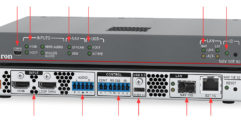Clarification
Aug 1, 1999 12:00 PM,
Alan Kruglak
A number of questions have arisen regarding my feature, “A Question ofBalance,” published in the May 1999 issue of S&VC. Generic video baluns donot offer common-mode isolation, a point that I did not clarifysufficiently. The illustrations on page 34 are used to show the basicconcept of balanced/unbalanced signal transformation, but neither of thebaluns depicted will isolate common-mode current problems. Only asolid-core or air-core transformer with two separate windings will suffice.
With proper design and selection of low-, high- and bandpass/band-rejectfilter elements, one can mix several AC (audio through RF) signals on thesame transmission line as long as frequencies do not overlap. Becausebaseband video contains modulation information that overlaps baseband audiofrequencies, mixing them is impractical.
We can, however, multiplex audio and RF-modulated video (not baseband, aswas stated) on the same pair of wires by using low-pass and high-passfilters. The RF-modulated signal would use a different pair of windings onthe balun from the audio signals to couple into the CAT 5 wiring system toachieve the proper transformation ratio.
ALthough line-level audio can be fed directly to CAT 5 wire, I would use atleast 1:1 ratio transformers at the source and load to minimize suchunwanted common-mode voltages, as those inductively coupled from powerlines, motors or other adjacent 60 Hz/120 Hz electromagnetic fields.Interference from these sources would not be heard on a communicationssystem with a narrow audio bandwidth, but it would come through on afull-bandwidth audio reinforcement system.
The discussion of signal loss in CAT 5 wire is intended to point out thatCAT 5 is not a practical alternative to coaxial cable. Using thecombination of a balun and CAT 5 wire results in greater signal attenuationthan conventional coax or even open wire. Not that the balun in particularis the culprit here, but because one must use a balun to connect coaxialcable to a twisted pair in any case, the combination makes for a lossysolution.
It appears that there is a minor disagreement on semantics. Having been anamateur radio operator for nearly 30 years and a builder of antennas forHF, VHF and UHF operation, I interpret a balun’s ratio to describe theimpedance transformation. When we needed to match a 200 V dipole drivenelement on a yagi to a 50 V transmitter, we called for a 4:1 balun, not2:1. I defer to numerous editions of The Radio Amateur’s Handbook, RSGBVHF/UHF Manual and The ARRL Antenna Handbook for this common usage.










